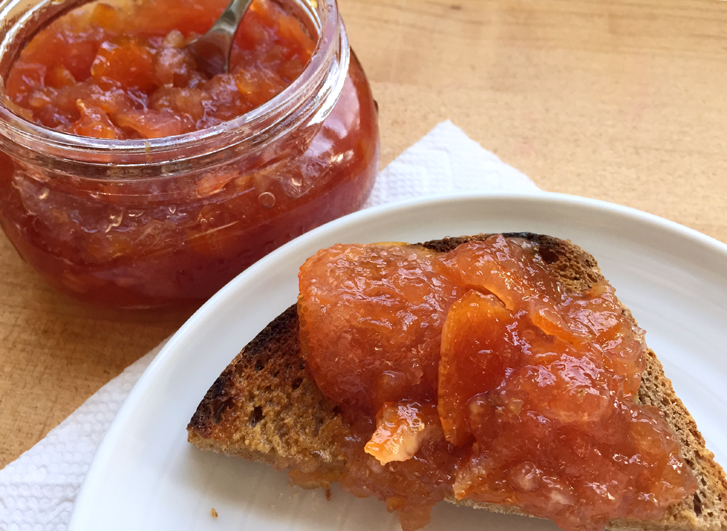March was full of activity Chez 650Food, and things have been busy, busy around here — lest you think I was taking a hiatus and had run off to some tropical beach. (sigh. I wish.). Following home reno projects, spring cleaning, and a trip to our nation’s capital for the International Association of Culinary Professionals (IACP) annual conference, I’m looking forward to a bit of calm (read: quiet) in April.
One project that I did manage to check off my list in March was a first attempt at canning (booyah!). Turns out that marmalade is a good solution for baby-stepping your way into canning, not to mention a delicious way to use up citrus fruits. In previous posts I’ve written about ways to enjoy a bounty of lemons (here, here, and here), but what about oranges? The last of the blood oranges are dwindling, but the navels and Valencias just keep a-comin’.

When I was doing research for a Waste-Less Wednesday post on herbs, I came across a recipe for Orange-Rosemary Marmalade in Jerry Traunfeld’s The Herbfarm Cookbook. Let me tell you: the recipe is fool-proof. You don’t have to be a professional cook or experienced canner to get this one right. Nor do you have to spend hours over the stove. Best of all, the recipe can easily be halved for smaller households (because, really, who has space for 6 jars of marmalade??).

Why is marmalade such a good choice for first-time canners?
- Fruit prep is simple: wash, dry, and slice.
- No special ingredients required: citrus fruits are high in pectin, a carbohydrate found in the cell walls of fruit, which acts as a gelling agent when combined with water. Citrus brings its own pectin to the party, which means that you don’t need to buy or add pectin.
- Not so time-consuming: Marmalade is fast! Total cooking time is 45-60 minutes, with the actual, hands-on part happening during the last 15 minutes or so.
- No food waste: marmalade is a total win because you use the whole fruit: rind, pith, and pulp! (No seeds, though. Make sure to remove those.)
Before pointing you to the recipe, it’s worth saying a few things about the elephant in the room: botulism. Many first-time canners are worried that they’re going to botulize themselves and their families, so here’s some info that might help ease your mind. First of all, cases of botulism are very rare in the US. According to the CDC, an average of 145 cases are reported annually, and only 15% of those are caused by food. (To put that in perspective, the US population is about 318.9 million people.)
Food-borne botulism that results from home-preserved foods typically occurs in low-acid, high-moisture foods, such as tomatoes, green beans, and beets. Citrus-based marmalade is a high-acid food. The boiling process reduces the moisture content significantly. Sterilizing the jars by boiling them for at least 10 minutes is essential to reducing any possible contamination as well. For more information about food-borne botulism, check out this article on botulism from the CDC and this detailed post about canning from Food in Jars.
So, thanks to the wonders of Google Books, you can check out the recipe yourself and make either a full or half batch as suits your needs. I made a half batch, which yielded 2 pint jars and a not-quite-full half-pint jar.
The ingredient list is short: oranges, lemon(s), sugar, water, rosemary. Choose organic fruit if you can, then you’ll only have to give it a quick rinse and scrub to remove any dirt.

lemon, rosemary) and filtered water
You can use any kind of orange, but the combo of blood oranges with rosemary elevates the marmalade’s flavor and gives it a pretty color. Plus, making marmalade now and preserving it for later means that you can enjoy blood oranges any time of year.

The recipe is a two-parter, so you’ll need to plan ahead a bit. On the first day, prep the fruit: wash, dry, slice in half and remove seeds, then slice the halves thinly. If you have a food processor with a slicing disk, you can get the work done in just a few minutes.

Sliced fruit goes into the pot with water for an overnight soak that softens the rinds and releases the pectin. On the second day, you boil the water and fruit for 30 minutes. The fruit will soften further as it cooks down and the pectin is released. The color will start to change from a rich blood orange to a pinkish-orange color.

After boiling the fruit for 30 minutes, add the sugar and rosemary sprigs (wrapped in cheesecloth and tied) and continue boiling for 15-30 minutes. This is the part where you want to be nearby and pay attention. You’ll also want to sterilize the pint jars by submerging them in boiling water for at least 10 minutes and sterilize the canning lids and bands in a separate saucepan.
As the marmalade mixture starts to gel, the bubbles will change from small, quick champagne-like bubbles to larger, thicker, more viscous bubbles. Once you see those larger bubbles (around 15-20 minutes in), do a “wrinkle test” to see if the marmalade has set up or needs to continue cooking.

Have a chilled plate waiting in the refrigerator or freezer. Spoon a small amount of marmalade jelly (not the fruit) from the pot onto the plate and return the plate to the refrigerator. Let the jelly chill for a minute or two, then test it by removing the plate from the refrigerator and pushing the jelly with your finger. If it wrinkles, your marmalade is finished and ready for canning. If it’s still smooth and syrupy, keep cooking. I found that the wrinkle test was positive at 27 minutes and my marmalade was done! (YMMV.)
You don’t need any special equipment for making this marmalade, other than some pint-sized canning jars with lids and lid bands. In the 650 you can find pint-sized jars sold in packages of 4 or 12 at Orchard Supply, Ace Hardware, Target, and Whole Foods.

The Ball Jar folks also make an inexpensive canning-tool “kit” that includes a jar lifter, headspace tool (for measuring how much space to leave below the mouth of the jar), wide-mouth funnel, and a magnetic lid lifter. The kit, which is available at Orchard Supply and Ace Hardware, is a “nice-to-have,” but not required. You can substitute items that you likely already have at home. Got a pair of kitchen tongs? Create a gripping jar lifter and lid lifter by wrapping a thick rubber band around each wide, scalloped end of the tongs. Keep a metal ruler handy for measuring headspace.
The real test of canning success is waiting to find out how well you sealed the jars. You won’t know until the jars have cooled almost completely whether or not you have a good seal. If you press on the center of the lid, and it doesn’t pop back at you, congratulations! You’ve got a good seal. Refrigerate jars that don’t have a good seal — or any about which you might be concerned. Also, refrigerate any jars that weren’t filled to the headspace recommended in the recipe. You’ll want to open and use those first.
I’ll admit to doing the happy dance in my kitchen when those lids didn’t pop back at me. Maybe it wasn’t a Tom Hanks “I have made fire!” (Castaway) moment, but it was pretty cool. Have you made marmalade? Share your experience or ideas in the comments.



2 thoughts on “Wasteless Wednesday: Blood Orange-Rosemary Marmalade”